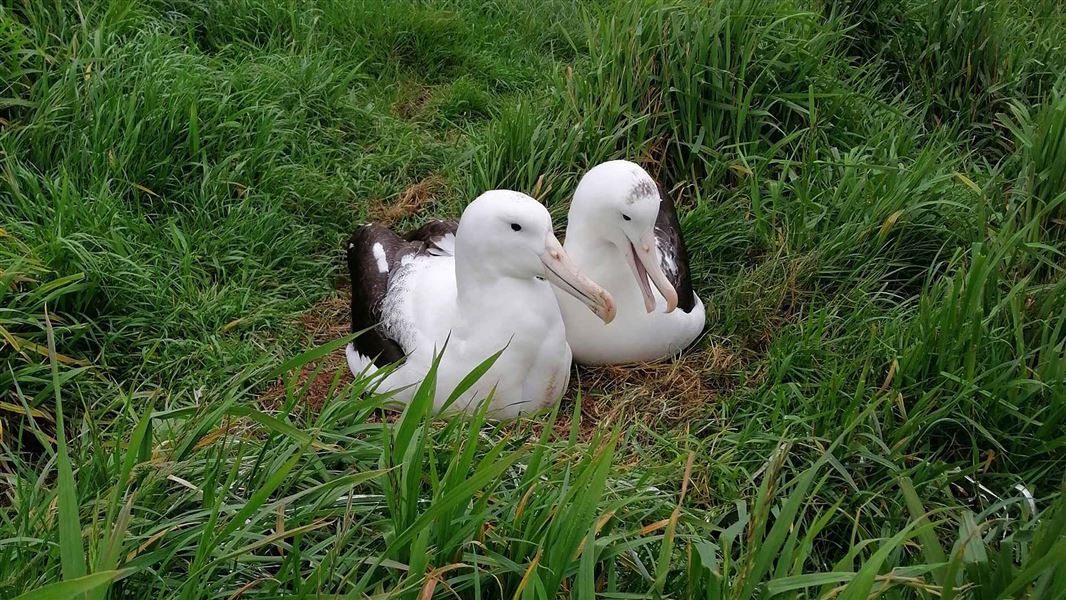Archived content: This media release was accurate on the date of publication.
Date: 10 December 2019
DOC’s popular Royal Cam albatross live stream will join Cornell Lab’s global network of live bird cameras this week, giving twenty million annual viewers the chance to learn more about the plight of albatross.
DOC Biodiversity Ranger Sharyn Broni says the new partnership is a major win for the northern royal albatross and will significantly increase the exposure of the bird to an audience of dedicated fans around the globe.
“Toroa is the largest seabird in the world with a wingspan of more than three metres. A record number of albatross chicks fledged here in October, and a new generation of chicks will soon be hatching. But it’s a dangerous world out there, and these birds face a variety of threats to their survival, once they leave the relative safety of the colony.”
Cornell Lab of Ornithology’s Charles Eldermire leads the global Bird Cams project and has been watching Royal Cam since its launch. He approached DOC last year to bring Royal Cam to the world’s stage.
“Seabirds like the northern royal albatross sit at the nexus of so many conservation issues that will face the world for the foreseeable future, such as climate change, unsustainable harvests, invasive species and habitat destruction,” says Charles Eldermire.
“Toroa are an incredible agent for opening hearts and minds to the challenges sea birds are facing globally. The scale at which these birds travel, crossing entire oceans and bypassing borders, makes them a powerful symbol for how wild birds connect us all.
“Cornell Lab are interested in seeing how we can help raise awareness of other birds by drawing the world’s eyes to the challenges they face.”
Cornell Lab and Hawaii’s Kauai Albatross Network previously live streamed the antics of Laysan albatross, receiving more than 6 million views from over 190 countries. Over five years, albatross fans tuned in to watch more than 150 million minutes of bird life. An even larger audience is expected to watch New Zealand’s live stream.
Cornell Lab has upgraded DOC’s existing web camera and the Royal Cam now features new capabilities like the ability to pan and night vision. Overseas, Cornell Lab’s cameras have caught predators roaming nests under the cover of darkness.
“We’re excited to see what albatross get up to in the evenings. Night vision also gives our international streamers the ability to tune in at any time of the day or night, when previously they would miss out on much of the albatross action due to different time zones,” says Sharyn Broni.
If Royal Cam proves a hit with Cornell Lab’s bird fans, there’s potential for other New Zealand species to get the same attention.
New Zealand is home to a quarter of the world’s population of seabirds and more than 4000 native species threatened or at the risk of extinction, such as hoiho/yellow-eyed penguin, kakī/blackstilt, whio/blue duck and the charismatic kākāpō.
DOC’s Royal Cam has been running at Pukekura/Taiaroa Head since January 2016, obtaining more than 3.5 million views from 199 countries. The camera has been hugely successful and has gathered a loyal following around the world, giving a bird’s eye view into DOC’s biodiversity work with toroa.
DOC manages the albatross colony with the support of the Otago Peninsula Trust, Te Poari a Pukekura (Pukekura Co-management Trust) and Dunedin City Council. It has grown from one breeding pair in 1937 to more than 60 breeding pairs in 2019.
Background information
Cornell Lab of Ornithology
The Cornell Lab of Ornithology is a not-for-profit conservation organization whose mission is to “…interpret and conserve the earth’s biological diversity through research, education, and citizen science focused on birds.”
Cornell Lab will stream Royal Cam on their Bird Cams website and DOC will continue to host the camera on its channels.
Northern royal albatross
- Northern royal albatross/toroa are an icon of Dunedin with a conservation status of ‘at risk - naturally uncommon’. They are a taonga species for Ngāi Tahu.
- Northern royal albatross have been nesting at Taiaroa Head for more than 80 years. The small population of birds travel as much as 190,000 km a year before returning to Dunedin.
- 10,000 seabirds also thrive at Pukekura/Taiaroa Head, including nationally vulnerable and threatened species like red-billed gulls and Otago shags.
DOC’s Royal Cam
Royal Cam has recorded the life of four albatross chicks from hatching to fledging. DOC has previously run an annual competition for Royal Cam fans to choose a name for a chick, the winning names were: Moana, Tūmanako, Amīria and Karere.
Contact
For media enquiries contact:
Email: media@doc.govt.nz
